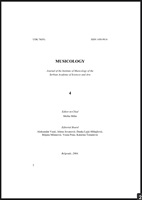Типиком непрописане причасне песме у новијој традицији српског црквеног појања
Communion Songs Not Regulated by the Typicon in the Recent Tradition of Serbian Church Singing
Author(s): Vesna Sara PenoSubject(s): Music, Eastern Orthodoxy, Sociology of Art, Sociology of Religion
Published by: Muzikološki institut SANU
Keywords: story song; music collections; Typical; Liturgy; More often; late Byzantine and Russian singing tradition; rosin; calophonic irmos; Kant;
Summary/Abstract: In notated collections of Serbian church hymns from the 19th and 20th century there are, among others, communion songs with texts that were not regulated by the Typicon. These so-called “arbitrary communion songs” have been very popular in the recent tradition of Serbian church chanting. They have been gradually pushing out the hymns that are regulated for singing on concrete days and feasts during the church year. Analysis of possible influences that determined the way texts and the melodies delved into the recent Serbian church chanting follows two possible directions. The first commenced from late-Byzantine singing tradition; more specifically, from a group of songs that although based on liturgical texts, were performed in extraliturgic occasions. These are calophonic irmoi which were composed by a great number of known late-Byzantine masters of singing. The second direction had its beginning in Russian spiritual music that generated a new melodic genre, kant, based on western models. The majority of those compositions have freely written spiritual texts, too, and not part of the liturgy. Kanti were, namely, singing numbers in liturgical dramas – theatrical pieces with Christian historical themes. The majority of arbitrary communion hymns from Serbian collections have texts from the psalms or use texts for irmoi of specific canons. There is only one text that does not belong to the output of church hymnography. In spite of that, the melodies of the analysed hymns reflect the presence of traditional compositional procedures characteristic of late-Byzantine and Serbian traditions. On either side, they possess atypical musical phrases that relate them to the the kanti. The usage of paraliturgical songs instead of communion hymns is commentated upon from the liturgic aspect also. That song belongs to the central part of the Liturgy and most fundamental during the service of the Orthodox church. Therefore, the deviation in Serbian practice from the rules that define its place and role demonstrate the distancing from the tradition, raises a fundamental question: is liturgical meaning being compromised.
Journal: Muzikologija
- Issue Year: 1/2004
- Issue No: 4
- Page Range: 121-152
- Page Count: 32
- Language: Serbian

